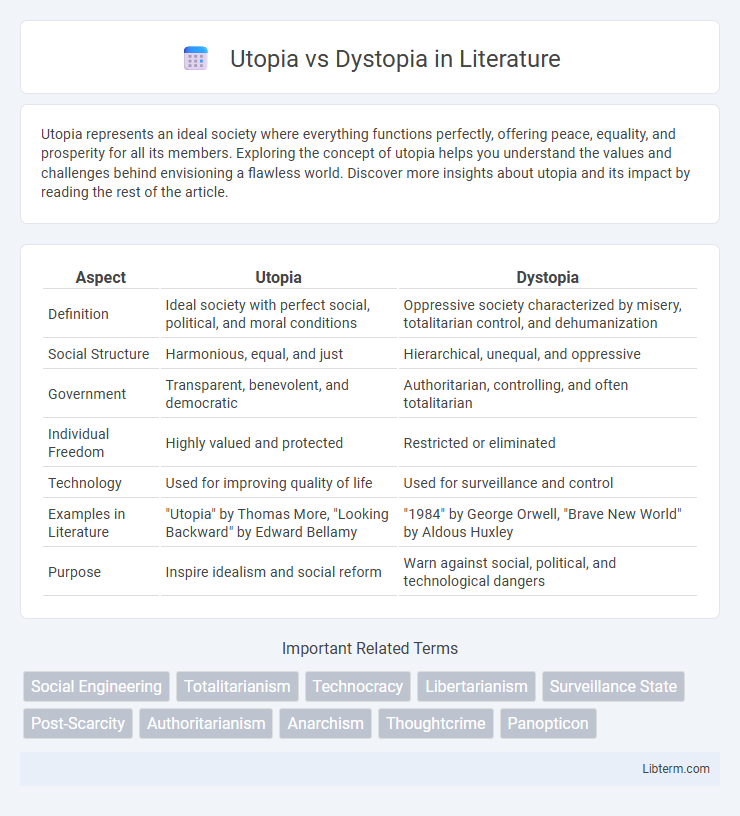Utopia represents an ideal society where everything functions perfectly, offering peace, equality, and prosperity for all its members. Exploring the concept of utopia helps you understand the values and challenges behind envisioning a flawless world. Discover more insights about utopia and its impact by reading the rest of the article.
Table of Comparison
| Aspect | Utopia | Dystopia |
|---|---|---|
| Definition | Ideal society with perfect social, political, and moral conditions | Oppressive society characterized by misery, totalitarian control, and dehumanization |
| Social Structure | Harmonious, equal, and just | Hierarchical, unequal, and oppressive |
| Government | Transparent, benevolent, and democratic | Authoritarian, controlling, and often totalitarian |
| Individual Freedom | Highly valued and protected | Restricted or eliminated |
| Technology | Used for improving quality of life | Used for surveillance and control |
| Examples in Literature | "Utopia" by Thomas More, "Looking Backward" by Edward Bellamy | "1984" by George Orwell, "Brave New World" by Aldous Huxley |
| Purpose | Inspire idealism and social reform | Warn against social, political, and technological dangers |
Defining Utopia and Dystopia
Utopia represents an idealized society characterized by harmony, equality, and abundance, where social, political, and economic systems function perfectly to ensure the well-being of all citizens. Dystopia, in contrast, depicts a society plagued by oppression, inequality, and suffering, often enforced through authoritarian regimes, environmental destruction, or widespread dehumanization. Both concepts serve as critical frameworks in literature and philosophy for exploring the potential consequences of current social trends and governance models.
Historical Origins of Utopian and Dystopian Concepts
The historical origins of utopian and dystopian concepts trace back to Plato's "Republic," which envisioned an ideal society based on justice and order, laying the groundwork for utopian thought. Thomas More's 1516 work "Utopia" coined the term and described an imagined perfect island society, influencing centuries of idealistic literature. Conversely, dystopian themes emerged prominently in the 20th century with works like George Orwell's "1984" and Aldous Huxley's "Brave New World," reflecting societal fears about totalitarianism, surveillance, and loss of individuality.
Key Characteristics of Utopian Societies
Utopian societies are characterized by idealized social, political, and economic systems designed to achieve perfect harmony and equality among citizens. Core features often include collective ownership, equitable resource distribution, absence of poverty, and governance based on rationality and justice. Emphasis on advanced technology, environmental sustainability, and universal access to education and healthcare also distinguishes utopian models from dystopian ones.
Core Elements of Dystopian Worlds
Dystopian worlds are characterized by oppressive societal control, pervasive surveillance, and the eradication of individual freedoms, often enforced by authoritarian regimes or totalitarian governments. Core elements include dehumanization through propaganda, restriction of truth, and the presence of constant fear or violence to maintain order. These settings highlight the consequences of extreme political, technological, or environmental corruption, contrasting sharply with idealistic utopias.
Utopia and Dystopia in Literature
Utopia and dystopia in literature represent idealized and nightmarish visions of society, respectively, serving as critical tools for social commentary and exploration of human nature. Classic works like Thomas More's "Utopia" envision perfect societies with harmony and justice, while dystopian narratives such as George Orwell's "1984" and Aldous Huxley's "Brave New World" depict oppressive regimes and loss of individuality. These literary genres use speculative settings to challenge contemporary political, ethical, and technological issues, prompting readers to reflect on possible futures and the consequences of current societal trends.
Technology’s Role in Shaping Utopias and Dystopias
Technology acts as a critical determinant in shaping utopias and dystopias by influencing societal structures and individual experiences. In utopias, advancements in artificial intelligence, renewable energy, and healthcare create seamless efficiency, equality, and enhanced quality of life. Conversely, dystopian scenarios often depict technology as a tool for surveillance, control, and social stratification, amplifying fear and oppression within rigid hierarchies.
Political and Social Structures Compared
Utopian societies feature egalitarian political systems with transparent governance, fostering social harmony and equal rights for all citizens. Dystopian societies often exhibit oppressive regimes marked by authoritarian control, surveillance, and social stratification, resulting in widespread fear and inequality. The contrast highlights how political power distribution and social organization significantly impact individual freedoms and community well-being.
Human Nature: Hope vs. Fear
Utopian societies often depict human nature as inherently hopeful, envisioning progress and harmony driven by optimism and trust in collective potential. In contrast, dystopian narratives emphasize fear as a fundamental aspect of human nature, illustrating how anxiety, oppression, and suspicion lead to control and societal breakdown. The tension between hope and fear shapes the moral and psychological landscapes of these contrasting worlds.
Real-World Examples and Influences
Real-world examples of utopia and dystopia often manifest in contrasting societal models such as the Scandinavian countries, frequently cited for their utopian welfare systems and high quality of life, versus totalitarian regimes like North Korea, representing dystopian realities marked by oppression and restricted freedoms. Influences on these concepts extend to literature and media, where novels like Aldous Huxley's "Brave New World" and George Orwell's "1984" reflect fears of dystopian futures, while movements like the cooperative community initiatives in places like Auroville, India, embody utopian ideals aimed at social harmony and sustainability. Understanding these examples highlights how utopian and dystopian visions shape political policies, cultural dynamics, and public aspirations globally.
The Enduring Appeal of Utopia vs. Dystopia
Utopia symbolizes humanity's enduring hope for an ideal society characterized by harmony, equality, and prosperity, while dystopia reflects fears of authoritarian control, environmental collapse, and social decay. The appeal of utopia lies in its visionary promise of perfection and moral progress, offering a blueprint for a better future that inspires innovation and reform. Dystopia captivates audiences by warning of potential consequences if current societal flaws go unaddressed, making both genres pivotal for exploring collective aspirations and anxieties.
Utopia Infographic

 libterm.com
libterm.com